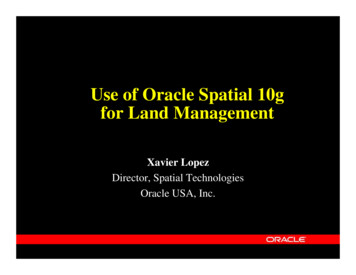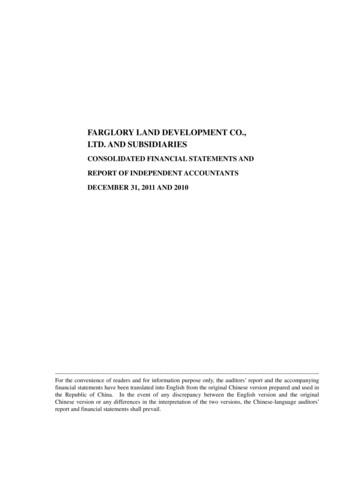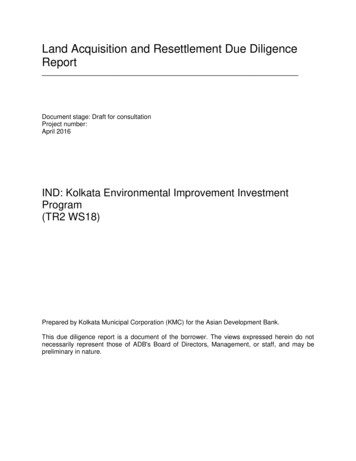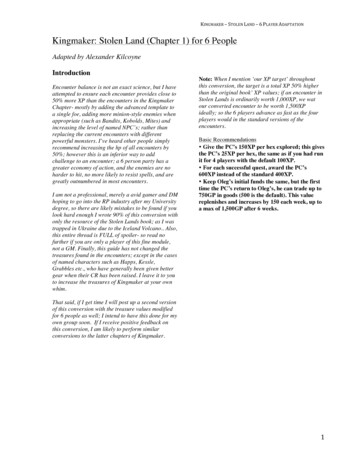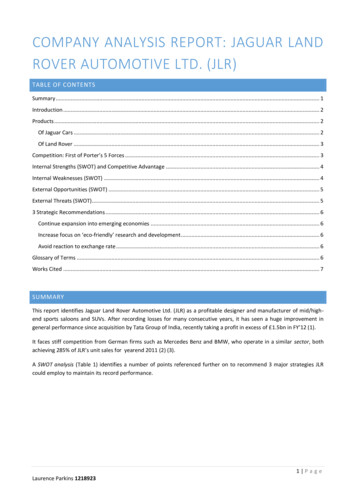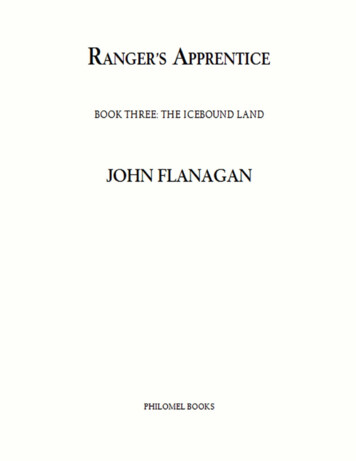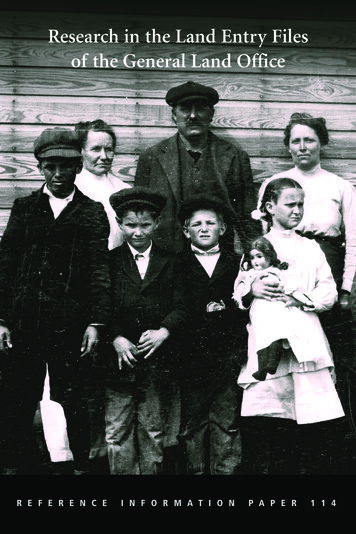
Transcription
Research in the Land Entry Filesof the General Land OfficeR E F E R E N C EI N F O R M A T I O NP A P E R1 1 4
Above: Since 1785 Federal land surveyors used the township as themajor subdivision of the public domain under the rectangular sys tem of surveys. Townships are approximately 6 miles on each sideand contain 36 sections of 640 acres apiece, numbered in thesequence above. Sections are further subdivided into half, quarter,and lesser sections, called aliquot parts. A township is identified byits relation to a base line and principal meridian, e.g., township 7south, range 26 west, Sixth Principal Meridian (6th PM).Front cover: “A ‘close up’ of a homesteader’s house of the better type,showing one of the ‘sure crops.’” Record Group 49, Records of theBureau of Land Management, General Land Office, Field ServiceDivision, Santa Fe, New Mexico.Back cover: The engraving that appeared on patent documents forland entries under the Homestead Act of 1862.
Research in the Land Entry Filesof the General Land OfficeRECORD GROUP 49C O M P I L E D B Y K E N N E T H H AW K I N SR E F E R E N C EI N F O R M A T I O NP A P E R1 1 4National Archives and Records Administration, Washington, DCRevised 2009
INTRODUCTIONThe National Archives and Records Administration (NARA) is the offi cial repository for records of the U.S. General Land Office, a predecessor ofthe Bureau of Land Management, that document the transfer of publiclands from the United States to private ownership.1 The case files generat ed by over 10 million such individual land transactions, known as landentries, and the tract books and various name indexes used to access themare located in the National Archives Building, Washington, DC.NARA has custody of the land entry case files for the 30 Federal public landstates. There are case files for all states in the United States except the origi nal 13 states, Vermont, Kentucky, Tennessee, Maine, West Virginia, Texas, andHawaii. These states were never part of the original public domain.2INFORMATION FOUND IN LAND ENTRY CASE FILESThese files can contain a wealth of genealogical and legal information.Depending upon the type and time period of land entry, the case file mayyield only a few facts already known to the researcher, or it may present newinsights about ancestors, family history, title, and land use issues. Case filesfor land entries made before the 1840s may contain only schematic infor mation such as the name of the entryman; the land’s location, acreage, andprice; and the date and place of the land entry. Or they may, in cases of mil itary bounty land warrants and private land claims, establish a record ofU.S. military service or reveal that the claimant settled a location before itwas annexed by the United States. Case files for land entries made afterabout 1840 under the Cash Act (1820), Preemption acts (1830s–1840s),Donation Act (1850), Homestead Act (1862), Mineral acts (1860s–1870s),Timber Culture Act (1873), Desert Land Act (1877), and several militarybounty land warrant acts (1840s–1850s) generally include more informa tion. The records can attest to the entryman’s age, place of birth, citizen ship, military service, literacy, and economic status, among other vital1 Pleasenote: Federal land records document only the FIRST transfer of title to land from the United Statesto another party. Records of later transfers may be found in county or state records. Contact the appropriatecounty recorder of deeds, state archives, or historical society.2 Some of the original colonies and eastern states also sold land and awarded military bounty land warrants on theirown. Researchers interested in such records should contact the appropriate state archives or historical society.1
information, and sometimes include similar information about familymembers. They also provide evidence of first title and occasionally of landuse, rights of ways, survey lines, crops and improvements, archeologicalimprints, and conflicting claims.Such information is not guaranteed to be in every land entry case file.Over 40 separate legislative acts were used by Americans to make a landentry on the public lands, and each act required different information fromthe entryman. Thus the documentation available in the land entry case filedepends largely upon the legal requirements of the act under which theland entry was made. Used imaginatively, however, even the smallest casefiles can establish locations of land ownership or settlement and datesessential to exploit other resources at NARA, such as census, court, and mil itary service and pension records.This publication is intended to provide an overview of the land entry filesheld at the National Archives Building and an introduction to research inthem. It cannot begin to detail the many additional records of the GeneralLand Office (GLO) that relate to land entries and land use available toresearchers at the National Archives Building and NARA’s regional recordsservices facilities. For more detailed information on land records, please seeRobert Kvasnicka’s The Trans Mississippi West, 1804–1912, Part IV, Section3, Records of the General Land Office (Washington, DC: National ArchivesTrust Fund, to be published in 2007).ARRANGEMENT AND ACCESS 3Land entry case files comprise the paperwork accumulated by a local U.S.land office in administering a land entry application. Once the legal require ments governing a land entry were met, whether by a cash payment, surren der of a bounty land warrant, or proof of residency and improvements, offi cials at the local land office forwarded the case file to the headquarters of theGLO in Washington, DC, along with a final certificate that declared it eligi ble for a patent. There the case file was examined, and if found valid, a patentor deed of title for the land was sent back to the local land office for deliveryto the entryman. The GLO also recorded each land entry in tract books3 Researchersmay wish to consult the tabular searchpaths printed at the end of this pamphlet.2
arranged by state and legal description of the land in terms of numberedsection, township, and range. The case files were retained and kept in sepa rate filing systems for military bounty land warrants, pre 1908 general landentry files, and post 1908 general land entry files.The United States issued bounty land warrants to attract enlistments dur ing the Revolutionary War, the War of 1812, and the Mexican War and toreward service in these conflicts and in a variety of Indian wars, Indianremoval, and other military actions during the 1850s. The GLO filed most ofthe military bounty land warrant case files by the year of the congressionalact that authorized them, the number of acres granted, and the warrantnumber. These three elements of information are required to identify andretrieve these files. Name indices and other means to access these files arediscussed below in the section on military bounty land warrants.Before July 1908, the GLO kept the case files for all general land entriesaccording to state, land office, type of entry (such as credit, cash, home stead, timber, and mineral), and final certificate number (sometimes calledthe file or document number). Large portions of the pre July 1908 landentry case files are not indexed by name. Selected name indices and othermethods to obtain the information required to identify and retrieve thecase files are discussed below.After July 1908, the GLO filed all general land entries regardless of stateor type in one large series by serial patent number. Name indices that pro vide the patent number of all post July 1908 land entries are available in theNational Archives Building through the mid 1950s when NARA holdingstaper off. For serial land patents after the mid 1950s, it may be necessary tocontact the relevant contemporary Bureau of Land Management (BLM)district office for the state in question.A name index to the pre July 1908 general land entry case files, main tained on file cards, is available for Alabama, Alaska, Arizona, Florida,Louisiana, Nevada, and Utah. Called the “Seven States Index,” 4 it showsthe entryman’s name, state in which the land was located, land office wherethe entry was made, type of entry, and final certificate or file number. Itthus supplies all four of the information elements needed to have a landentry case file retrieved or “pulled” for examination. It also shows the legal4 SevenStates Index, RG 49, Master Location Register number (MLR #) UD168.3
description of the land in terms of numbered section, township, and range.The Seven States Index includes both successful land entries that receivedpatents and unsuccessful land entries, also called canceled or relinquishedland entries, which did not receive patents. NARA has case files for bothpatented and unpatented land entries before 1908.The four information elements noted above are also required to retrievepre July 1908 general land entry files for the remaining 23 public landstates. Some researchers may already have possession of this informationbecause they have a copy of the U.S. patent issued for the land. Those whodo not have this information must obtain it from the General Land Officetract books or other sources. The present location of these tract booksdepends on whether the GLO’s successor agency, the Bureau of LandManagement, categorized the public land states as “eastern” or taNevadaMississippiNew MexicoMissouriNorth DakotaOhioOklahomaWisconsinOregonSouth DakotaUtahWashingtonWyomingGLO tract books for the 17 western public land states listed above are heldat the National Archives Building in Washington, DC. A map index to eachstate’s tract books allows researchers to identify the tract book number thatcovers the area in which they are interested. Some GLO tract books are held4
by NARA’s regional records services facilities and occasionally by otherrepositories in western public land states. See “Using the Tract Books” below.The Eastern State Office of the Bureau of Land Management (BLM ESO), 7450 Boston Boulevard, Springfield, VA 22153, has retained custodyof the GLO tract books for the 13 eastern public land states. The BLM ESOalso has a computerized index of patented land entries for all public landstates post 1820, excluding land patents prior to 1908 located in Montana,Nebraska, and Oklahoma. This index is on the BLM web site at www.glo records.blm.gov. Complete entries from this index give the informationneeded to locate given case files at NARA. Land offices and types of landentries are given for some states in the system as code numbers, and thefinal certificate number is designated the “document number.”Since GLOARS covers only patented entries, it does not serve as an indexto pre 1820 entries (with some sporadic exceptions regarding land war rants) and the many thousands of canceled or relinquished land case filesgenerated in the course of the Federal public land business. Such case filesoften have as much information useful to the researcher as those of patent ed entries. To obtain file information on cancelled entries in the easternstates, researchers much consult the headquarters tract books of the GLOtract books in the custody of the Bureau of Land Management’s EasternStates Office. Tract books used by branch offices of the GLO may be held bystate repositories in public land states, but these are not as authoritative asthe central office tract books held respectively by the BLM and NARA.USING THE TRACT B O OKS AT THENATIONAL ARCHIVES BUILDINGThese large bound volumes document all general and bounty land war rant land entries before and after 1908 and provide the information ele ments needed to identify and retrieve land entry case files for examination.The information recorded includes the type of land entry; its legal descrip tion in terms of numbered section, township, and range; its acreage andprice; the name of the entryman; date of application and/or patenting; andthe final certificate, serial patent, or warrant number. The tract books alsocontain additional information affecting all land entries in a given area,such as the local land office handling entries, rights of way, forest reserves,5
Indian reservations, and state lands.The tract books are arranged by numbered section, township, and rangein what is termed a “legal description” of the land. In order to use the tractbooks effectively, the researcher must know the legal description of theland parcel in which they are interested. Civil divisions such as countiesand named townships were not used by the GLO and therefore are of lim ited use to the researcher using its records. Legal description of land canusually be obtained from the county recorder of deeds and is shown alsoon some commercial atlases. For more information on the legal descriptionof land, see “A Note on Cadastral Surveys” below.To identify the number of the tract book covering any given piece of landin a western public land state, the researcher should consult the tract bookindex map for that state.5 Each map shows the principal meridian and baseline governing land surveys in the state, as well as the numbered townshipsand ranges that appear as a grid covering the entire state. The researcherwill locate the appropriate numbered township and range for their area andfind that it is included with a group of others in a block designated by atract book volume number. The researcher should request that tract bookby state and volume number.Once the tract book is in hand, the researcher can locate the record of theland entry under the appropriate numbered section, township, and rangelisted on the left side of each page in the volume. Each land entry wasrecorded in the tract book across two pages. Once the record of the landentry is located, the researcher must extract the information needed toretrieve and examine the land entry case file.REQUESTING THE LAND ENTRY CASE FILEEach request for a land entry case file must include the following informa tion elements: Pre July 1908 general land entries require the state, landoffice, type of land entry, and final certificate number. Post July 1908 generalland entries require name of entryman and serial patent number. Bountyland warrants require the year of the congressional act authorizing the war 5 Indexto Tract Books, RG 49, MLR# UD2321, maps arranged by state. Copies of these maps are availablefor consultation in room G 28 of the National Archives Building, Washington, DC.6
Tract book illustration 1Tract book illustration 27
rant, acreage, and warrant number. The location of each of these within thetract book entry is illustrated on page 7.61. The type of land entry was usually abbreviated in the far left column:Homestead entries were abbreviated as “Hd,” “H.E.,” or “Home.” Cashentries were “P.a.” or “Pre. 41,” for the preemption act of 1841, or “cash.”Timber Culture entries were “T.C.” Desert entries were “D.E.” Military boun ty land warrant entries were routinely cited on either the left or right tractbook page and varied in format but always included the year of the actauthorizing the warrant, the acreage, and the warrant number. (Also shown:the legal description of the land entries, the acreage, price or fees paid, andthe name of the entryman.) Enter the type of entry on your request form.2. The final certificate or patent number is located in different parts ofthe right tract book page, depending on the type of land entry and its dispo sition. If it was a cash or preemption entry, the file number was usuallyrecorded under the column headed “Number of receipt and certificate ofpurchase.” If it was a Homestead Act, Timber Culture Act, or Desert Land Actentry, this column was used for the application number.7 The file number forthese types of entries was usually entered under the “By Whom Patented” or“Date of Patent” columns as the final certificate,“F.C.,” or patent,“Pat.,” num ber. Enter the appropriate number on your request form.3. Because the pre July 1908 general land entry case files are arranged bytype and number under the name of the land office, it is essential that thecorrect land office be cited in any request for these files. Each state had upto a dozen different land offices for various areas and time periods. Theland office that administered the land entry was sometimes listed on theright tract book page, near the final certificate or patent number. In caseswhere the land office was not cited in the tract book, researchers can con sult an index prepared by the GLO that is arranged by state, meridian,township, and range and chronicles the time periods during which variousland offices administered the public lands in any given area.8 Enter theappropriate land office on your request form.6 Kansas,tract book vol. 75, p. 35, for sections 31 and 32, township 7 south, range 26 west.Homestead Act, Timber Culture, and Desert Land land entries, the application number became the finalfiling number only if the land entry was canceled, relinquished, or commuted to a cash entry by purchase.Such dispositions were recorded on the right hand page of the tract book. Land entry case files so notedshould be requested as such.8 Index to Land Offices, 4 vols., MLR# UD2320.7 For8
When these information elements are obtained, correct requests for pre 1908 land entry case files from the Oberlin, Kansas, land office would readlike this:Kansas, Oberlin land office, Homestead final certificate #4758[Gottlieb Sandmeier]Kansas, Oberlin land office, cash entry #4111 [Charles W. Little]Kansas, Oberlin land office, canceled Homestead #17115 [John W.Gordon]Kansas, Oberlin land office, Timber Culture final certificate #1274[William Flesher]Land entries patented after 1908 do not require citation of the land officeto retrieve the case file; they require only the patent number. A post 1908serial land patent entry from the same land office might read:Serial Land Patent No. 64998 [Henry A. Russell]Learning what information elements are required to retrieve a land entrycase file and entering them correctly on the request form, without extrane ous or incomplete information, will enhance the accuracy and efficiency ofthe retrieval and research process.A NOTE ON CADASTRAL SURVEYSThe cadastral elements of principal meridian, numbered section,township, and range governed the survey and disposition of the publiclands in the United States. As each territory or state came within the publicdomain, the GLO established a base line running east and west and a prin cipal meridian north and south to guide land surveys. Numbered town ships were laid out in tiers north and south of the base line while numberedranges were laid out east and west of the meridians. The intersecting linesof townships and ranges formed a checkerboard or grid of townships, eachcontaining 36 sections. Each section of a township contains 640 acres andis 1 square mile in area. Typical land entries consisted of parcels between 40acres and 320 or more acres, usually in increments of 20 acres. NARA hasoriginal GLO survey notes for Illinois, Indiana, Iowa, Kansas, Missouri,and Ohio and original GLO township plats for Alabama, Illinois,Indiana, Iowa, Kansas, Mississippi, Missouri, Oklahoma, Wisconsin, and9
parts of Ohio. They are reproduced in NARA microfilm publications T1240and T1234, described in the microfilm section. Survey notes and plats forother public land states generally are held by the Bureau of LandManagement, (BLM) Eastern States Office, and various BLM state offices.Often the public lands of one or more states are governed by a singleprincipal meridian. For example, all of Kansas and Nebraska and most ofWyoming and Colorado base their land surveys on the Sixth PrincipalMeridian (6th PM).The base line of the 6th PM forms the state boundary betwee
the Bureau of Land Management, that document the transfer of public lands from the United States to private ownership. Thecase files generat ed by over 10 million such individual land transactions, known as land entries,and the tract books and various name indexes used to access them are located in the Na
